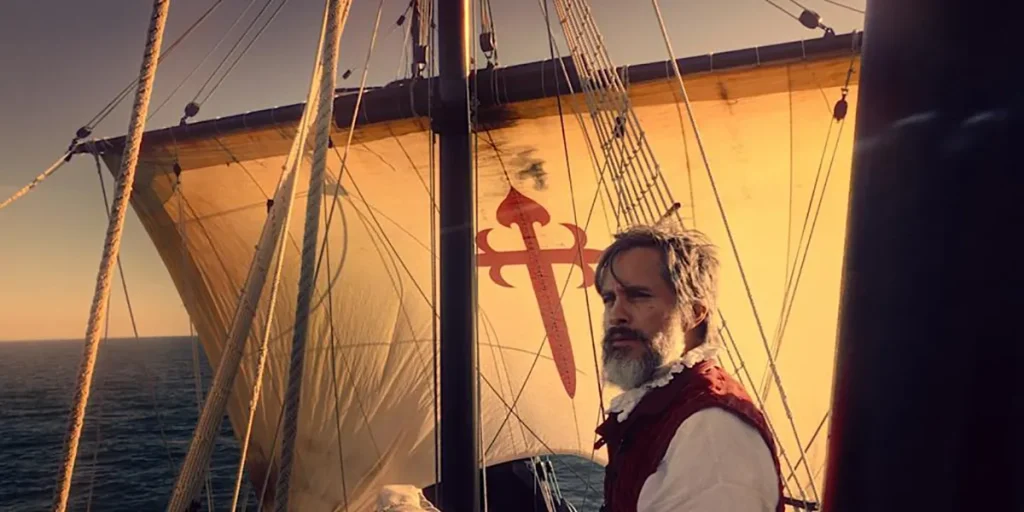Lav Diaz’s Magellan showcases beautiful landscapes, but the colonial critique drags under its director’s artistic temperament.
Director: Lav Diaz
Original Title: Magalhães
Genre: Drama, Historical
Run Time: 160′
BFI London Film Festival Screening: October 11-12, 2025
U.S. Release Date: TBA
U.K. Release Date: TBA
Revisiting history in new, better-informed contexts is not as straightforward as it may seem. As narratives and legacies become more complicated, the responses they evoke in art can offer a flurry of forthright responses. Magellan is an attempt to review the impact the voyage of Ferdinand Magellan had on the Philippines, but Filipino director Lav Diaz struggles to decide who his audience is, resulting in a film that frustrates and fascinates in about equal measure.
Purely by virtue of being a Lav Diaz film, Magellan was meant to be different from any comparable films about the era of European exploration and conquest of the new world. Dashing acts of heroism are in short supply, but so too are arguments about the ethics of what Magellan (Gael García Bernal, of Y Tu Mamá También) and his men are doing in Asia. Magellan is probably as accessible as Diaz’s films get, but he is a resolute adherent to the philosophy of slow cinema, and no amount of genre expectation will change that. A number of Diaz’s films are among the longest features yet made, and while Magellan runs at a comparatively paltry 2.5 hours, it is imbued with the same patience as his longer opuses.
That patience is not what we got in films like 1492: Conquest of Paradise or Christopher Columbus: The Discovery (That 1992 double whammy should ensure we never get a film about Columbus again), but then Magellan is not interested in mainstream appeal. It has its moments of planning for the voyage, life at sea, and the difficulties of settlement, but it primarily functions as a series of tableaux, creating vivid images that convey the key ideas of Diaz’s script. Dialogue and action are secondary to the painterly visions he crafts.
Bare-chested natives wander the forests in quietude as they go about their business. The sun sets behind Magellan’s ship, the Trinidad, in a blaze of orange. Eventually these two worlds will collide, with bodies strewn on a water-lapped shore bathed in a crepuscular purple. Diaz shares cinematography duties with regular collaborator Larry Manda and Spanish DoP Artur Tort to frame shots that contrast the Philippines’ natural beauty with the polished but corrupting influence of the Spanish settlers.
In between the natural vistas afforded by the Philippine forests, Diaz nods to ripe and relevant forebears. Meetings between Magellan and church leaders recall both the intimacies of Rembrandt’s paintings and Scorsese’s Silence, another vision of religious mission corrupted by pride. With not a little bit of national pride, Diaz paints the colonisation of the Philippines as a folly, forever framing the Spanish as ill-fitting to their new environs.
This tack invites comparison to Aguirre, the Wrath of God, but Magellan doesn’t have Werner Herzog’s bloodymindedness willing it into being, and its beauty can’t compare to Herzog’s singular sticky and foggy vision. A more reasonable point of comparison might be The New World, but where Diaz and Terrence Malick share a common awe for the natural world, Malick’s camera roves and explores in ways that Diaz is just too determined and stately to follow. For all the beauty of Diaz’s frames, Magellan sometimes leaves the viewer wishing that something would actually happen.
Magellan attempts to walk a line between Diaz’s on-brand artistry and something a little more palatable to a wider audience. The choice of a known figure from history makes the story a little more accessible, as does the casting of Bernal, who delivers another fine portrait of necessary stoicism being barely held together. Magellan is offered interiority in scenes with his wife (Ângela Azevedo), but for all these efforts, Magellan the man feels lost in his story. This is partly by design on Diaz’s part, but the beauty of his vistas and rigour of his frames overtakes any sense of deeper analysis of why the Spaniards are undertaking their mission. The film’s predictable tone stops it from ever getting out of second gear.
Magellan may be released in a context that’s more critical of the history behind it, but the sedate pace prevents it from ever feeling truly topical. Producer Albert Serra married slow cinema’s methods to more urgent messaging in Pacifiction, one of 2022’s best films, but Diaz can’t replicate that film’s slow-building paranoia, lest it undermine his onscreen craft. Magellan may be one of the most visually striking films of the year, but it looks more urgent than it actually is.
Magellan: Movie Plot & Recap
Synopsis:
In the early 16th century, Ferdinand Magellan leads a Spanish expedition of conquest, but the natives of the Philippine islands will not take kindly to the invaders’ jackboot.
Pros:
- The film looks astonishing, shot in muted but sumptuous natural colours
- It has undeniable atmosphere, with Diaz inviting the viewer to to sit and watch history unfold
Cons:
- The slow pace denies the events a sense of urgency, potentially undermining the film’s message
Magellan (Magalhães) will be screened at the BFI London Film Festival on 11-12 October, 2025.

